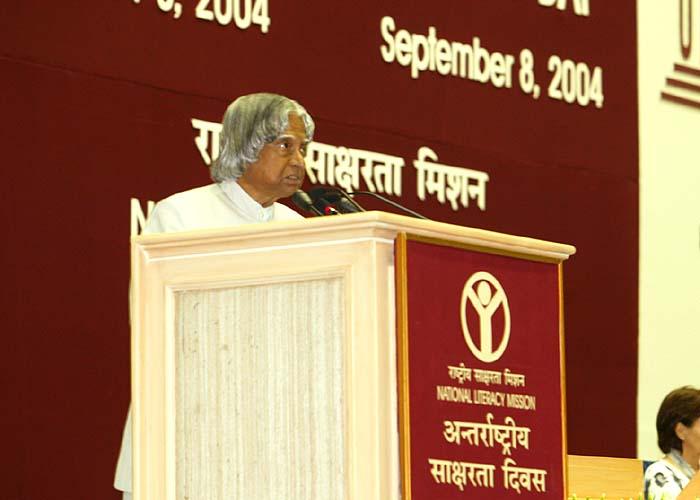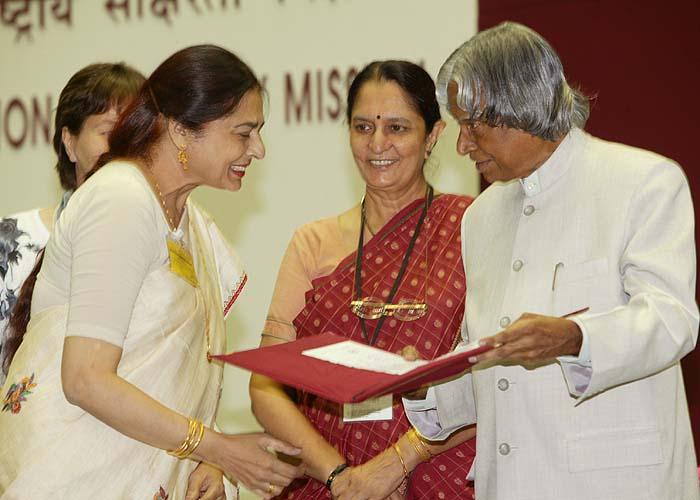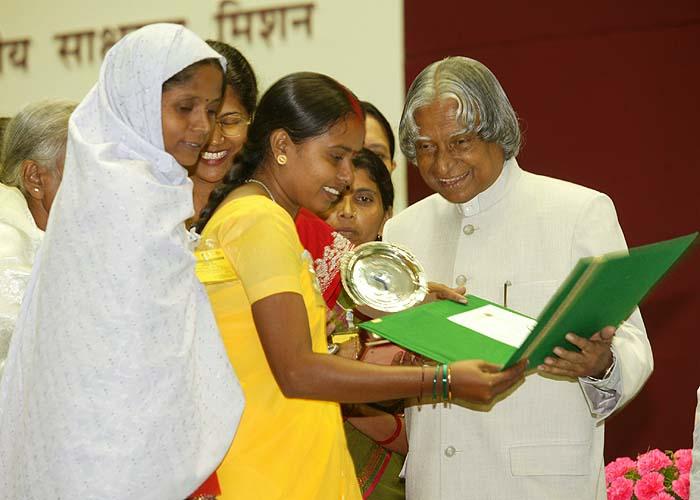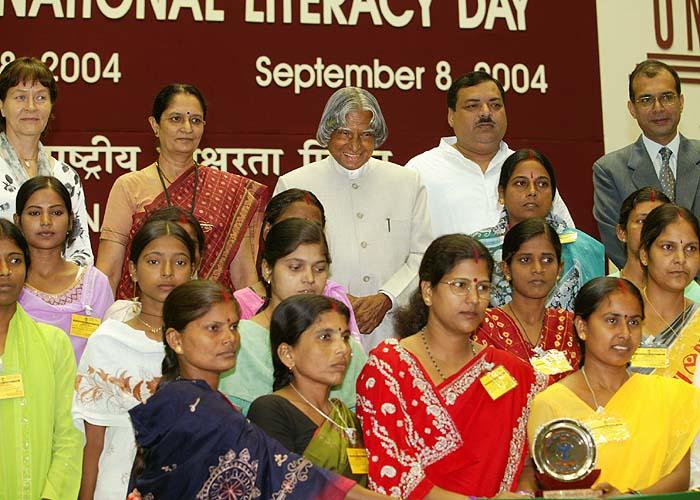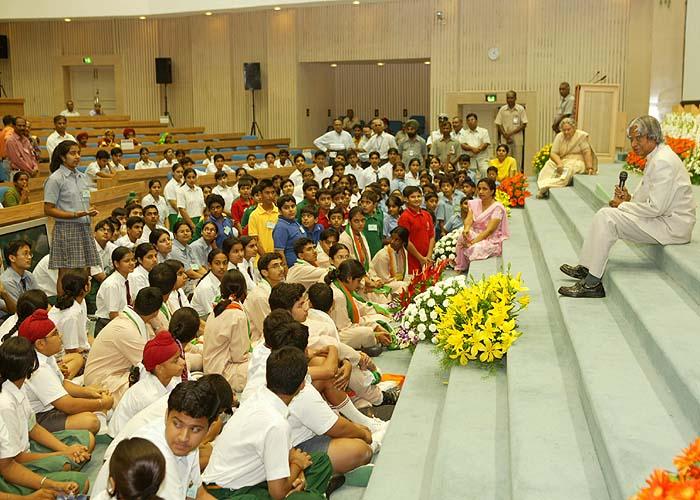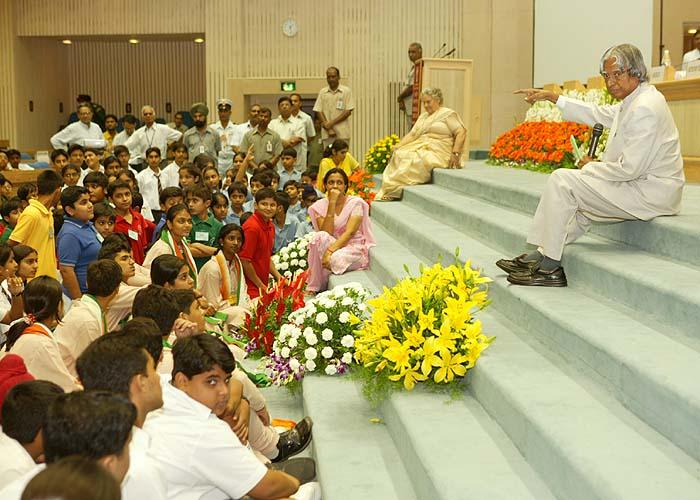Address At The 38th International Literacy Day
Vigyan Bhavan, New Delhi : 08-09-2004
Mission Mode for Total Literacy
I am indeed delighted to participate in the 38th International Literacy Day being organized by the Ministry of Human Resource Development. I greet the organizers, education planners, state level institutions, non-government organisations, principals, teachers and students. I congratulate the recipients of Satyen Maitra Memorial Literacy Award and NLM ? UNESCO Award for the year 2003 for their excellent work in promoting the literacy movement very effectively in their regions.
Literacy Status
For any nation, the level and quality of education is one of the most significant parameters for development. In India, the total literacy has gone up over the years but the quality needs tremendous improvement. Education is not just the ability to read and write but also a complete process of human transformation.
The synergy between education and learning has to be well perceived and operationalized. Education is essentially an aid to generate worthwhile learning. Learning itself is ultimately an individualized and lifelong process, whereby human transformation occurs within the individual. Learning has various forms such as: pre-learning, reinforcement of learning, classroom learning, individualized and independent learning of small groups or large masses, enrichment learning, self-learning and self-directed or self-managed learning. Final result of learning is the application of knowledge and skills for the benefit of the society, nation and the world.
Origin of National Literacy Mission
I understand that the National Literacy Mission launched on 1988 as a technology mission to impart functional literacy to non-literates in the country in the age group of 15 ? 35 years in a time bound manner. Later, National Literacy Mission was recognized as one of the three instruments to eradicate illiteracy from the country, the other two being universalisation of elementary education and non-formal education.
Methods of Achieving Total Literacy
The goal of National Literacy Mission is to achieve a sustainable threshold literacy rate of 75% by 2007 by imparting functional literacy to non-literates in the age group 15 to 35. When we see the literacy data of the country through the 2001 Census, our national literacy works out to overall 65% whereas, the male literacy is 75% and female literacy is 54%. There is, however, a wide disparity in the literacy rates of different states - Kerala has achieved 90% cent literacy while Bihar is only 38.5%.
The first breakthrough came in Kerala, in Kottayam town followed by Ernakulam district where the literacy campaign was initiated in 1989 and completed within a year. For the first time, an area-specific, time bound volunteer-based campaign approach had been implemented and the community becomes responsible for running its own development programmes and consequently determining its future. This model needs to be implemented in all the States for getting time bound progress towards eradication of illiteracy.
Quantification of Problem
Firstly, we have to assess the quantum of problem. If we take 2001 Census as the base, and we have to reduce the illiteracy from the existing 35% to 25% by the year 2007, we need to educate at least 14 million people per year. But the present statistics shows that we are not able to achieve a target greater than 7 or 8 million people per year. This requires an immediate correction. A massive drive is required to double the yearly output of the total literacy programme for which we can adopt the following methods.
My Experience with School Children
During the last two years, I have met over five lakh school children. They have all been asking me as students what areas they can contribute in assisting transforming India into a developed nation. I have been telling them that they should participate in the literacy mission and educate at least five members who cannot read and write in their neighbourhood or in the nearby village. This they should do during the weekly holidays and school vacation period without affecting their own studies. They have promised me that they will do this service for the nation.
The Ministry of Human Resource Development can promote this concept and create National Literacy Camps in all the regions during the vacation in collaboration with the State Governments and non-governmental organisations. Also it is to be ensured that more thrust should be given to women education. If this is done the women in the house will educate more members in the family leading to reduction of illiteracy in the family. While doing so, it should also be ensured that children in the age group 6 to 14 positively attend school. Here again we have to create a good school environment and pre-school training so that the dropouts of young children from school are avoided. I have also been meeting the Vice-Chancellors of various universities who are willing to undertake adult literacy programme as an outreach programme through their affiliated colleges. If these three avenues are adopted complementarily I am sure we can become a fully literate India very soon.
Multi-pronged Approach to Achieve Total Literacy
As a first step, I would suggest that the Ministry Human Resource Development to put a yearly target of 14 million people to be educated in the age group of 15 to 35 years during the year 2004-05 by having a mission mode programme through the involvement of school children and the universities for promoting adult literacy in addition to the existing adult literacy mission projects.
We can deploy 1.4 million children assisted by one lakh school teachers spread all over the country to educate at least 7 million adults who cannot read and write. The period in which they can provide intensive training can be for two academic years. The programme should provide higher priority to this scheme for states having low literacy rate.
Also we can deploy the universities whose prime responsibility is education, research and creation of enlightened citizens. They should look beyond the campus and see what opportunities we have to help the society. One of the possible schemes they can undertake is a literacy mission to the nearby rural areas. We have nearly 300 universities and 11000 colleges. We have to cover literacy programme for 5,83,000 villages and many urban areas. If each university can reach to villages in 10 kms distance through their 11000 colleges and help 1000 adults to be educated we will see in a two year period 11 million adults go through education. This should be done in addition to the present adult literacy programme which are educating nearly 7 to 8 million people per year. The combined effect of the three schemes put together will enable us to realize a target of educating 14 million adults every year.
Conclusion
As a nation we have the responsibility to enhance the dignity of all our citizens. This can be achieved only through quality education. Education in its real sense is the pursuit of truth. It is an endless journey through knowledge and enlightenment. Such a journey opens up new vistas of development of humanism where there is neither scope nor room for pettiness, disharmony, jealousy, hatred or enmity. It transforms a human being into a wholesome whole, a noble soul and an asset to the universe. Universal brotherhood in its true sense becomes the sheet anchor for such education. Real education enhances the dignity of a human being and increases his or her self-respect. If only the real sense of education could be realized by each individual, and carried forward in every field of human activity the world will be so much a better place to live in. I wish all success to the Ministry and all participating organizations in their endeavour to achieve total literacy for the nation in a time bound manner.
May God Bless You.
Question and Answer Session
1. How can we control our population?
Ans: Our population of one billion is an important component for the nation. It is true that our population is increasing day by day. Women?s education and girl education is the key. Some states by doing this have succeeded.
2. What are you going to do about corrupt political leaders?
Ans: You have a vote by the time you are 18. Select good guys.
3. Can we stop the war inside our hearts in our society?
Ans: It has to start from children. Righteousness in the mind leads to righteousness in thinking, this lead to beauty in character, which leads to harmony in the home. Only three people: father, mother and teacher and if you are lucky, grand parents can make you an enlightened person.
4. Should we not have the right to recall our elected representatives or have the option of none of the above on the ballot paper?
Ans: This is a good suggestion. I will tell it to the Chief Election Commissioner.

